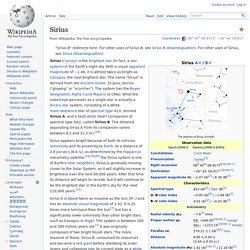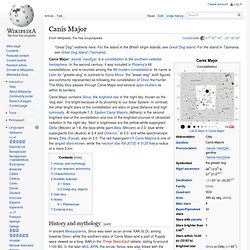

Sirius. Sirius appears bright because of both its intrinsic luminosity and its proximity to Earth.

At a distance of 2.6 parsecs (8.6 ly), as determined by the Hipparcos astrometry satellite,[5][19][20] the Sirius system is one of Earth's near neighbors. Sirius is gradually moving closer to the Solar System, so it will slightly increase in brightness over the next 60,000 years. After that time its distance will begin to recede, but it will continue to be the brightest star in the Earth's sky for the next 210,000 years.[21] Sirius A is about twice as massive as the Sun (M☉) and has an absolute visual magnitude of 1.42.
It is 25 times more luminous than the Sun[7] but has a significantly lower luminosity than other bright stars such as Canopus or Rigel. Observational history[edit] Sirius, known in ancient Egypt as Sopdet (Greek: Σῶθις Sothis), is recorded in the earliest astronomical records. The indigenous Boorong people of northwestern Victoria named Sirius as Warepil.[42] Kinematics[edit] Messier 41. Messier 41 (also known as M41 or NGC 2287) is an open cluster in the Canis Major constellation.

It was discovered by Giovanni Batista Hodierna before 1654 and was perhaps known to Aristotle about 325 BC.[3] M41 lies about four degrees almost exactly south of Sirius, and forms a triangle with it and Nu2 Canis Majoris—all three can be seen in the same field in binoculars. The cluster itself covers an area around the size of the full moon.[4] It contains about 100 stars including several red giants, the brightest being a spectral type K3 giant of apparent magnitude 6.3 near the cluster's center, and a number of white dwarfs.[5][6][7] The cluster is estimated to be moving away from us at 23.3 km/s.[1] The diameter of the cluster is between 25 and 26 light years. Its age is estimated at between 190 and 240 million years old.
M41 is also referred to as NGC 2287. Walter Scott Houston describes the appearance of the cluster in small telescopes:[8] See also[edit] References[edit] Coordinates: Canis Major. Canis_Major_IAU. Canis Major. An image of Canis Major (top right) as seen from an airplane at around 8 degrees north (Andaman Sea west of Thailand).

Canis Major contains Sirius, the brightest star in the night sky, known as the 'dog star'. It is bright because of its proximity to our Solar System. In contrast, the other bright stars of the constellation are stars of great distance and high luminosity. At magnitude 1.5, Epsilon Canis Majoris (Adhara) is the second brightest star of the constellation and one of the brightest sources of ultraviolet radiation in the night sky. Next in brightness are the yellow-white supergiant Delta (Wezen) at 1.8, the blue-white giant Beta (Mirzam) at 2.0, blue-white supergiants Eta (Aludra) at 2.4 and Omicron1 at 3.0, and white spectroscopic binary Zeta (Furud), also at 3.0.
History and mythology[edit] In non-western astronomy[edit] Canis Major as depicted in Urania's Mirror, a set of constellation cards published in London c.1825. Characteristics[edit] Notable features[edit] Stars[edit]